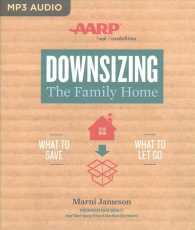- ホーム
- > 洋書
- > 英文書
- > Architecture
Full Description
Comprises a collection of papers presented at the 7th International Conference on Harmonisation between Architecture and Nature, this volume reviews the challenges and new opportunities of contemporary architecture. These papers cover the results of advances in design and new building technologies, as well as the development of new materials.
Many of the changes are motivated by a drive towards eco-architecture, trying to harmonise architectural products with nature. Another important issue is the adaptation of the architectural design to the natural environment, learning from nature and traditional construction techniques.
Never before in history have architects and engineers had such a range of new processes and products open to them. In spite of that, the construction industry lags behind all others in taking advantage of a wide variety of new technologies. This is understandable, due to the inherent complexity and uniqueness of each architectural project. Advances in computer and information systems, including robotics, offers the possibility of developing new architectural forms, construction products and building technologies, which are just now starting to emerge.
Changes have also taken place in the way in which modern society works and lives, due to the impact of modern technologies. Patterns of work have been disrupted and changed, affecting transportation and the home environment. The demand is for a new type of habitat that can respond to the changes and the consequent requirements in terms of urban environment.
The papers contained in this book deal with topics such as building technologies, design by passive systems, design with nature, cultural sensitivity, life cycle assessment, resources and rehabilitation and many others including case studies from many different places around the world. They will be of interest to architects, engineers, planners, physical scientists, sociologists and economists.
Contents
Contents
The environment and Feng Shui application in Cheong Fatt Tze Mansion, Penang, Malaysia; Eco-traditional courtyard houses in UAE: a case study of the Sharjah museums; Landscape compatibility of factories: from practices to tactics; Health-oriented evaluation of the spatial distribution of urban green space in the Wuhan inner city area of China; Users' perception and evaluation of campus eco-open spaces at the University of Lagos, Akoka Campus, Nigeria; A representational framework for sustainable design; Circular city: a methodological approach for sustainable districts and communities; Innovative circular solutions and services for new buildings and refurbishments; Living with water: a case study for coastal mixed-use multifamily residential structures; Lightweight reconfigurable structure system (LRSS): rethinking temporary buildings; Innovative approach to sustainable material sourcing and its impact on building performance; A shape grammar approach to climatically adaptable facade systems with real time performance evaluation; Hygrothermal simulation: use for service life prediction and maintenance of facades; Rethinking the building envelope: building integrated energy positive solutions
Author index







